Ball Gowns: A Gallery of Finery
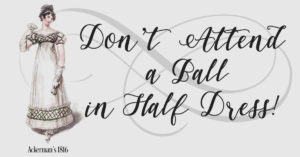
Get ready to drool–and maybe raise a few eyebrows–at ball gowns of Austen’s day.
If you missed the first part of this series, you can find links at the bottom of this post.
Now that we’ve been instructed on the proper style of dress to wear to a ball and on the finer points of good taste, lets dig into the ball gowns themselves for a bit, shall we?
Ball gowns in a nutshell
As we examine the details of these gowns, one thing to keep in mind is the Regency era cost of textiles. Unlike today where the workmanship is often the biggest element of cost, then, it was the price of the fabric, lace and trims that made gowns a major outlay. As a result, most could not afford to let any of that go to waste.
That ladies recycled their gowns was simply a given. Even in well-off circles like those the Bennets of Pride and Prejudice occupied, it was simply expected that the younger sisters were wearing gowns the older girls had first enjoyed and before that, the gown was probably redone at least once, possibly more than that, depending on the whims of recent fashions. Only the wealthiest might see it was something to sneer at. Though Caroline Bingley criticized the Bennet sisters, recycling garments was not among the shortcomings she noted.
Minor dress adjustments were made with lace, ribbons and embroidery (which accomplished girls were generally skilled at.) Embroidery patterns, especially whitework, were readily available in many fashion magazines. Ruffles, poufs and other trims, possibly made from scraps saved from the gown’s original fabrics, could also be added. If major modifications in the gown’s shape were made—changing sleeve length, adjusting bodice and waistlines, removing trains—trimmings would be scrupulously saved for possible use later in gowns and accessories. There was a reason why sewing, both fancy and plain was considered a necessary accomplishment for even wealthy and high-ranking women. (Read more about ladies’ accomplishments HERE.)
Fabrics
Less expensive dresses were made of fine muslin, not cheap by any means, but much more accessible than other options: silk, satin, crepe (made from silk or wool), and sarsenet (made from silk.) Since light and sheer fabrics were de rigueur, dresses were often layered. Delicate, diaphanous options for overdresses included fine India muslin, lace, gossamer net, imperial crepe, tulle, and figured or spotted gauze. These overdresses were often worn over a base of a white muslin, silk or satin slip-style dress.
Color
Today the little black dress is ubiquitous in a lady’s wardrobe. During the Regency era, it was all about the white dress. Ironically, exactly the reasons many shy away from white today drew Regency women to the color. Because white soils easily and is difficult to maintain, it was a proclamation of wealth. Effectively it said, “Look, I can afford servants to maintain this ridiculous color!” Ok, maybe not exactly that, but you get the idea. In the fine fabrics of the era, white was also very sheer and could show a ladies—assets—quite effectively, especially backlit by a fireplace or the like. So, yeah, it was the way to go, especially for young ladies. Accessories and trims were relied upon to bring in a bit of bright or bold color.
Older ladies (in particular, married ladies) were encouraged to go for more somber colors in their evening attire. If they insisted on wearing white, accessories like shawls should add that necessary pop of color.
Shape
Gowns from the Regency era featured a very distinct shape that set them apart from the ornate, structured and often enormous gowns worn in the earlier Georgian or later Victorian periods. On the whole, ball gowns featured bare necks, low—sometimes dangerously so—necklines, short, often puffy, sleeves, and long, relatively narrow skirts, decorated mostly at the hemline.
The Regency bodice exposed a lot of skin at the neck, shoulders, back and bosom. Not surprisingly A Lady of Distinction found such displays indecorous and often vulgar. (See the previous installment of this series HERE to read more about her opinions.) She also spoke very strongly against the shelf silhouette that characterized the era. (The effect was achieved with a corset, much like today’s longline push-up bras, designed to push the bust up rather than to narrow the waist.)
The bosom, which nature has formed with exquisite symmetry in itself … has been transformed into a shape, and transplanted to a place, which deprives it of its original beauty and harmony with the rest of the person. This hideous metamorphose has been effected by mean of invented stays or corsets… A vile taste in the contriver, and a stupid an approval by a large majority of women, have brought this monstrous distortion into a king of fashion: and in consequence we see, in eight women out of ten… the bosom shoved up to the chin, making a sort of fleshy shelf, disgusting to the beholders and certainly most incommodious to the bearer. p 95
Waistline heights fluctuated throughout the era, though all of them remained well above the natural waistlines. This created a very short bodice in the gowns which could present challenges for the wearer. She could not raise her arms very high without risking exposing too much or—well honestly—something falling out of her bodice, especially if well-endowed. That was one of the reasons young ladies were discouraged from taking up the violin as an accomplishment, but I digress …
Formal gowns might or might not include a train. Certainly it was a show of conspicuous consumption to include extra fabric in a gown that only served to drag the floor and get in the way if one were dancing. If a girl wearing a trained gown was intending to dance, she signaled her availability as a partner by pinning up her train. Some have suggested that gowns specifically intended for dancing were made without trains. But I haven’t been able to find period references that confirm the idea. It makes a great deal of sense, which, because fashion usually doesn’t, makes me a little suspicious that it would have been so cut and dry a distinction.
Accessories
Gloves
Gloves were always worn with evening dress. The only time they were removed was for eating. (Eating with gloves on was considered vulgar.) Aside from that, a proper gentlewoman must be protected from skin touching skin—shocking!
Many fashion prints show white gloves for evening, although other colors occasionally appear. Glove length varied according to sleeve length, the apparent goal being to keep as much skin covered as possible. Even so, long gloves, worn with short sleeves, were often loose and shown in prints bunched up below the elbow. (Mind you, A Lady of Distinction warns if your arms are ah—unattractive—you should keep your gloves draw up high with a drawstring, ribbon, or armlet.)
Shawls
Shawls were often shown with evening wear, which only makes sense when one considers how thin the dress fabrics were. Remember, the fireplaces of the day were not incredibly efficient at putting heat into a room, and buildings were often very cold during the winter. Bold Kashmir shawls were often worn during cold seasons. In warmer seasons, silk, gauze and muslin shawls might be worn. The shawl’s overall size varied, but could be as long at eight feet in some fashion years.
Headdress
Generally, hats and bonnets were not worn during the evening, especially for dancing. That is not to say the head would be unadorned. Turbans often made an appearance for evening, but again, not great for vigorous dancing. Feathers, ribbons, and fancy ornaments were often woven into hair arrangements, with older women often sporting more elaborate adornments. Sometimes thin braids of hair were used to decorate the hairdo rather than accessories.
Shoes
Evening shoes were always slippers of some sort, typically of satin or kid leather. They could be very plain, in bright colors to match an ensemble, and even heavily embroidered. One trait they shared in common is that they were not designed for outside wear. Dancing slippers could be worn out in a single evening of vigorous dancing. Evening slippers were a bit more durable, but would not stand up to a great deal of walking about outside. It was not uncommon for a lady to change shoes as soon as she arrived at an event to protect her fragile evening wear.
So with this in mind, let’s take a peek at some of the fashion prints of gowns for the era. Keep an eye out for how much sin is exposed by the bodice, the accessories, embellishments on the skirts, and the interesting headdresses–there’s one that I’m still wondering what is on her head!
Gallery images from Ackermann’s, Incryoables et Merveilleuses, Costume Parisien, and La Belle Assemblee, all public domain.
Reference
Regency Etiquette: The Mirror of Graces (1811). Enl. ed. Mendocino, CA: R.L. Shep;, 1997.

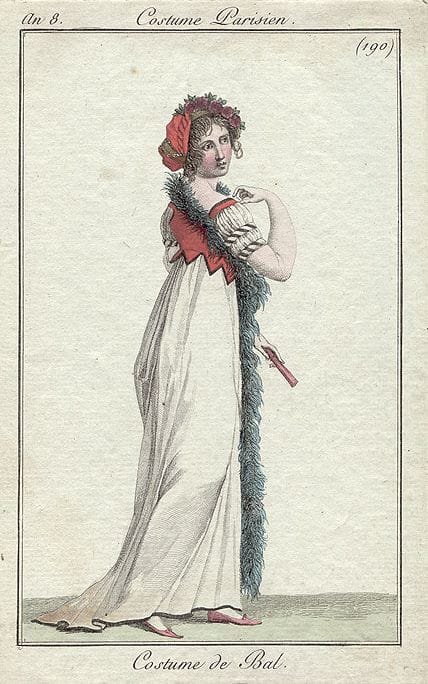
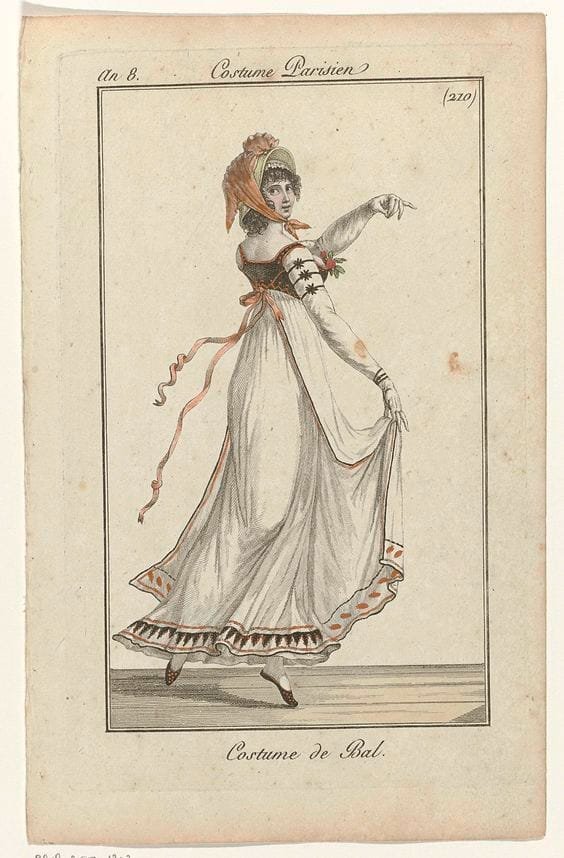
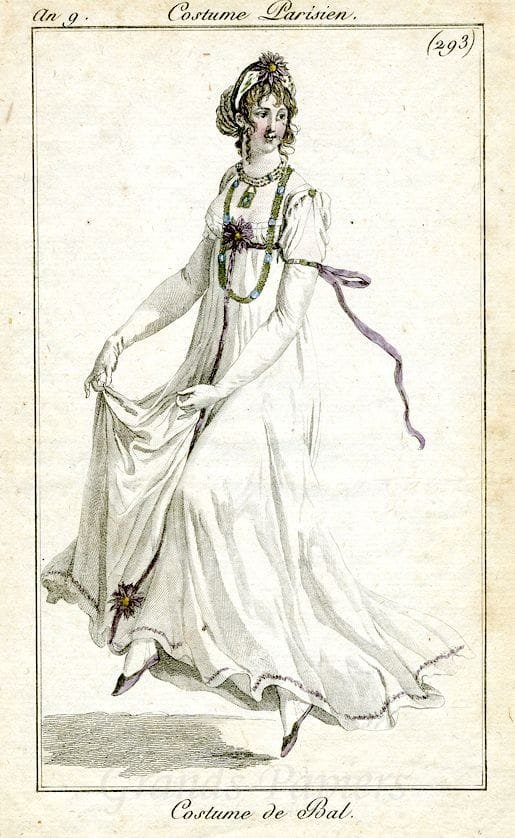
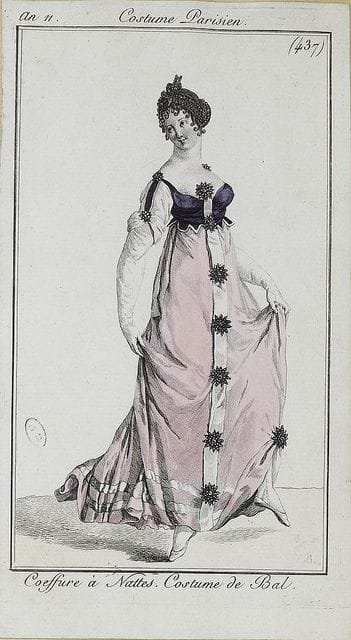
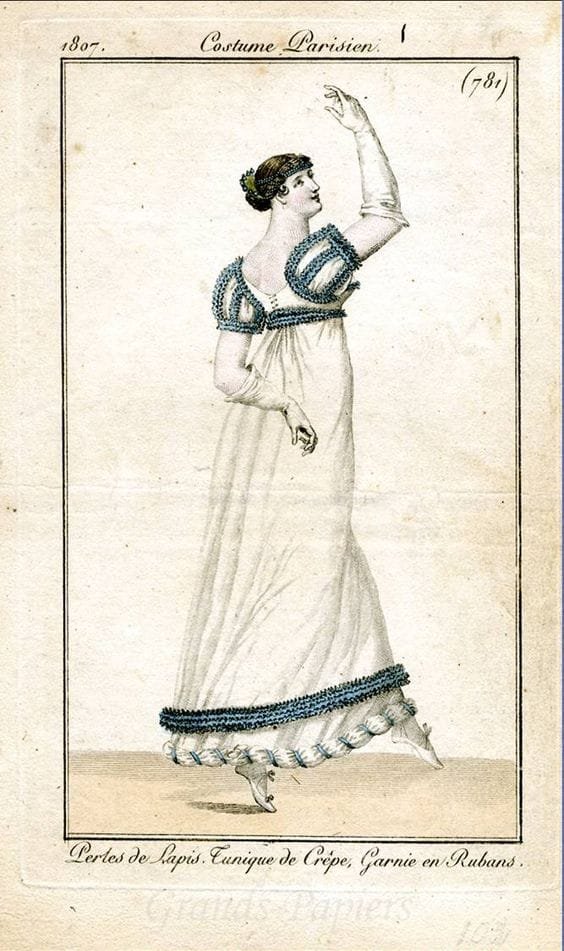
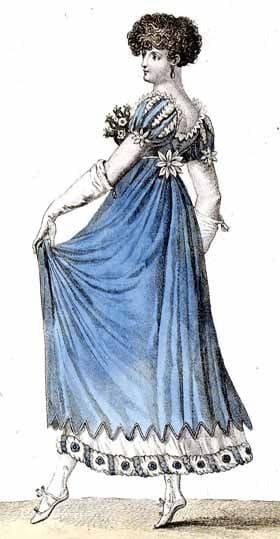
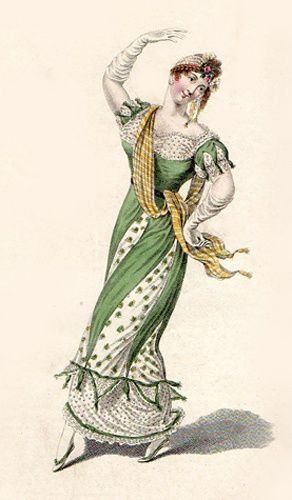
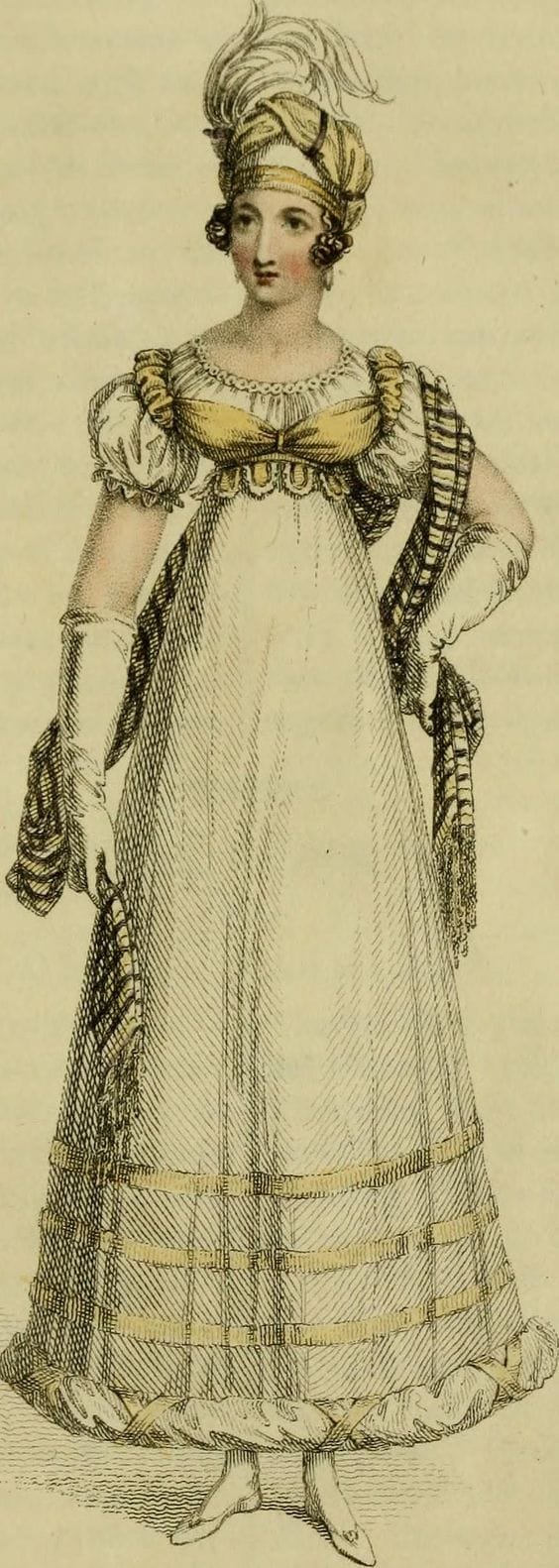
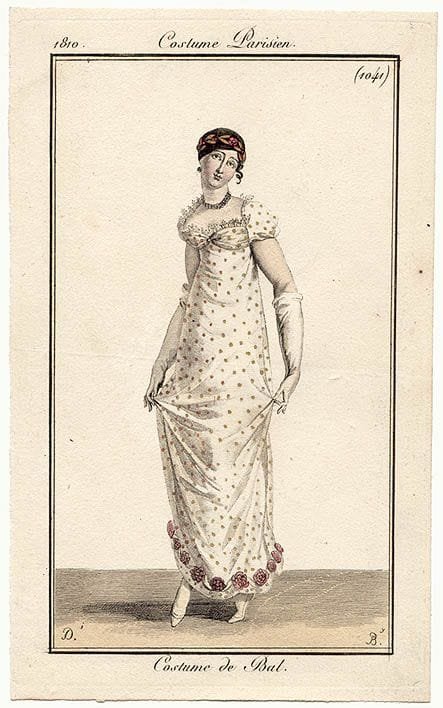

Comments
Ball Gowns: A Gallery of Finery — No Comments
HTML tags allowed in your comment: <a href="" title=""> <abbr title=""> <acronym title=""> <b> <blockquote cite=""> <cite> <code> <del datetime=""> <em> <i> <q cite=""> <s> <strike> <strong>